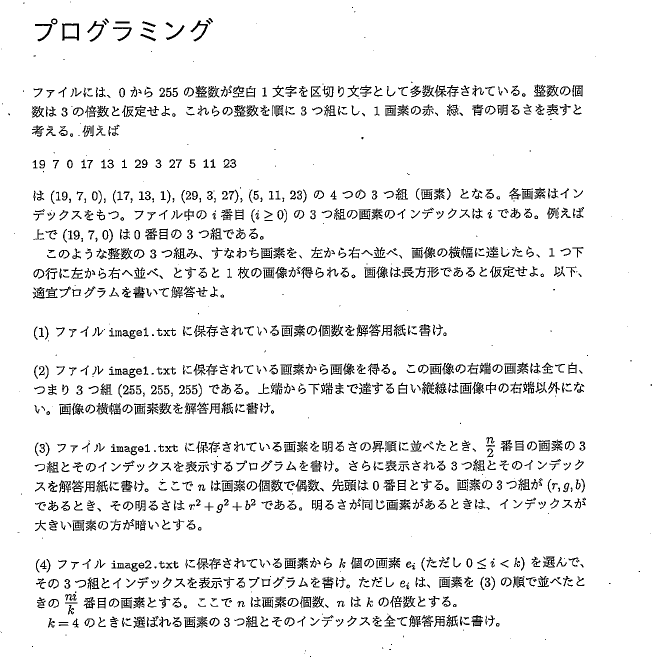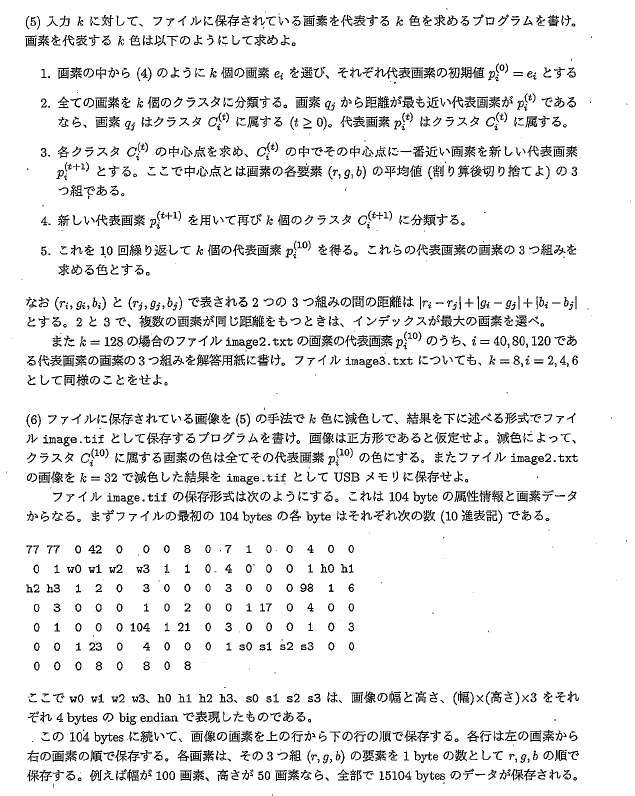2019年度夏の院試の解答例です
※記載の内容は筆者が個人的に解いたものであり、正答を保証するものではなく、また東京大学及び本試験内容の提供に関わる組織とは無関係です。
出題テーマ
- 画像圧縮
- byteへ変換そしてbinary書き出し
問題文
※ 東京大学側から指摘があった場合は問題文を削除いたします。

配布ファイル
※ 公開されていないので以下は筆者が適当に作ったものです
image1.txt
19 7 0 17 13 1 29 3 27 5 11 23 0 0 0 255 255 255
19 7 0 255 255 255 29 3 27 5 11 23 0 0 0 255 255 255
19 7 0 17 13 1 255 255 255 5 11 23 0 0 0 255 255 255
19 7 0 17 13 1 29 3 27 255 255 255 0 0 0 255 255 255
19 7 0 17 13 1 29 3 27 255 255 255 0 0 0 255 255 255
1 1 1 10 10 10 100 100 100 50 80 46 96 71 1 255 255 255
(1)
# (1)
file_path = 'image1.txt'
def solve(file_path):
with open(file_path, mode='r') as f:
ret = []
lines = f.readlines()
for line in lines:
ret.extend(line.rstrip('\n').split(' '))
print(int(len(ret) / 3))
(2)
import sys
sys.path.append('..')
import IsStrNumber as isn
from Divisors import divisors
file_path = 'image1.txt'
def is_white(cell):
total = 0
for c in cell:
total += c
return total == (255 * 3)
def solve(file_path):
array = []
cells = []
with open(file_path, mode='r') as f:
lines = f.readlines()
for line in lines:
array.extend(line.rstrip('\n').split(' '))
for i in range(0, int(len(array) / 3)):
idx = i * 3
cell = [isn.STRtoNumber(array[idx]), isn.STRtoNumber(array[idx+1]), isn.STRtoNumber(array[idx+2])]
cells.append(cell)
cell_num = len(cells)
divs = divisors(cell_num)
width = 0
for div in divs:
if (width != 0):
break
col_num = div
row_num = int(cell_num / div)
for i in range(0, row_num):
right_end_cell = cells[i * col_num + col_num - 1]
if (not is_white(right_end_cell)):
break
if (i == row_num - 1):
width = col_num
print(width)
(3)
import sys
sys.path.append('..')
import IsStrNumber as isn
import numpy as np
file_path = 'image1.txt'
def is_white(cell):
total = 0
for c in cell:
total += c
return total == (255 * 3)
def light_degree(cell):
ret = 0
for c in cell:
ret += c**2
return ret
def solve(file_path):
array = []
cells = []
with open(file_path, mode='r') as f:
lines = f.readlines()
for line in lines:
array.extend(line.rstrip('\n').split(' '))
for i in range(0, int(len(array) / 3)):
idx = i * 3
cell = [isn.STRtoNumber(array[idx]), isn.STRtoNumber(array[idx+1]), isn.STRtoNumber(array[idx+2])]
cells.append(cell)
cell_num = len(cells)
divs = divisors(cell_num)
cell_order = np.array(range(0, cell_num))
def cmp(order):
cell = cells[order]
return light_degree(cell)
sorted_cell_order = sorted(cell_order, key=cmp)
cell_idx = sorted_cell_order[int(cell_num / 2)]
print('index: {0}, {1}'.format(cell_idx, cells[cell_idx]))
(4)
import sys
sys.path.append('..')
import IsStrNumber as isn
import numpy as np
file_path = 'image1.txt'
def is_white(cell):
total = 0
for c in cell:
total += c
return total == (255 * 3)
def light_degree(cell):
ret = 0
for c in cell:
ret += c**2
return ret
def solve(file_path, k):
array = []
cells = []
with open(file_path, mode='r') as f:
lines = f.readlines()
for line in lines:
array.extend(line.rstrip('\n').split(' '))
for i in range(0, int(len(array) / 3)):
idx = i * 3
cell = [isn.STRtoNumber(array[idx]), isn.STRtoNumber(array[idx+1]), isn.STRtoNumber(array[idx+2])]
cells.append(cell)
cell_num = len(cells)
cell_order = np.array(range(0, cell_num))
def cmp(order):
cell = cells[order]
return light_degree(cell)
sorted_cell_order = sorted(cell_order, key=cmp)
def pr(index):
print('index: {0}, {1}'.format(index, cells[index]))
for i in range(0, k):
idx = int(cell_num * i / k)
cell_idx = sorted_cell_order[idx]
pr(cell_idx)
(5)
import sys
sys.path.append('..')
import IsStrNumber as isn
import numpy as np
file_path = 'image1.txt'
def is_white(cell):
total = 0
for c in cell:
total += c
return total == (255 * 3)
def light_degree(cell):
ret = 0
for c in cell:
ret += c**2
return ret
def distance(cell1, cell2):
return abs(cell1[0] - cell2[0]) + abs(cell1[1] - cell2[1]) + abs(cell1[2] - cell2[2])
def solve(file_path, k):
array = []
cells = []
with open(file_path, mode='r') as f:
lines = f.readlines()
for line in lines:
array.extend(line.rstrip('\n').split(' '))
for i in range(0, int(len(array) / 3)):
idx = i * 3
cell = [isn.STRtoNumber(array[idx]), isn.STRtoNumber(array[idx+1]), isn.STRtoNumber(array[idx+2])]
cells.append(cell)
cell_num = len(cells)
cell_order = np.array(range(0, cell_num))
def cmp(order):
cell = cells[order]
return light_degree(cell)
sorted_cell_order = sorted(cell_order, key=cmp)
def pr(index):
print('index: {0}, {1}'.format(index, cells[index]))
# 最終的なclassterを代表するcellに対応するindexを入れていく
# initialize
representative_cells = []
# classterに属する画素indexをそのclasster(array)に格納して管理
# initialize
classter_cells_array = []
for i in range(0, 11):
classter_cells = []
for j in range(0, k):
classter_cells.append([])
classter_cells_array.append(classter_cells)
def get_cell(order_idx):
return cells[sorted_cell_order[order_idx]]
# 並べ替えた後(sorted_cell_order)のindex: t = 0
for i in range(0, k):
idx = int(cell_num * i / k)
representative_cells.append(get_cell(idx))
# cellを分類する
def classify(t, idx):
cell = get_cell(idx)
classified_idx = 0
min_dis = 30000
for i in range(0, k):
representative_cell = representative_cells[i]
dis = distance(representative_cell, cell)
if (dis <= min_dis):
classified_idx = i
min_dis = dis
classter_cells_array[t][classified_idx].append(idx)
# cellをclasster分け : t = 0
for i in range(0, len(sorted_cell_order)):
cell = get_cell(i)
classify(0, i)
def center_cell(classter):
r = 0
g = 0
b = 0
for i in classter:
cell = get_cell(i)
r += cell[0]
g += cell[1]
b += cell[2]
return [int(r / len(classter)), int(g / len(classter)), int(b / len(classter))]
for t in range(1, 11):
for i in range(0, k):
representative_cells[i] = center_cell(classter_cells_array[t-1][i])
for j in range(0, len(sorted_cell_order)):
cell = get_cell(j)
classify(t, j)
print(representative_cells)
(6)
import sys
sys.path.append('..')
from math import sqrt
def intsqrt(num):
return int(sqrt(num))
import IsStrNumber as isn
import numpy as np
file_path = 'image1.txt'
def is_white(cell):
total = 0
for c in cell:
total += c
return total == (255 * 3)
def light_degree(cell):
ret = 0
for c in cell:
ret += c**2
return ret
def distance(cell1, cell2):
return abs(cell1[0] - cell2[0]) + abs(cell1[1] - cell2[1]) + abs(cell1[2] - cell2[2])
def solve(file_path, k):
array = []
cells = []
with open(file_path, mode='r') as f:
lines = f.readlines()
for line in lines:
array.extend(line.rstrip('\n').split(' '))
for i in range(0, int(len(array) / 3)):
idx = i * 3
cell = [isn.STRtoNumber(array[idx]), isn.STRtoNumber(array[idx+1]), isn.STRtoNumber(array[idx+2])]
cells.append(cell)
cell_num = len(cells)
divs = divisors(cell_num)
# initialize
cell_order = np.array(range(0, cell_num))
def cmp(order):
cell = cells[order]
return light_degree(cell)
sorted_cell_order = sorted(cell_order, key=cmp)
def pr(index):
print('index: {0}, {1}'.format(index, cells[index]))
# 最終的なclassterを代表するcellに対応するindexを入れていく
# initialize
representative_cells = []
# classterに属する画素indexをそのclasster(array)に格納して管理
# initialize
classter_cells_array = []
for i in range(0, 11):
classter_cells = []
for j in range(0, k):
classter_cells.append([])
classter_cells_array.append(classter_cells)
def get_cell(order_idx):
return cells[sorted_cell_order[order_idx]]
# 並べ替えた後(sorted_cell_order)のindex: t = 0
for i in range(0, k):
idx = int(cell_num * i / k)
representative_cells.append(get_cell(idx))
# cellを分類する
def classify(t, idx):
cell = get_cell(idx)
classified_idx = 0
min_dis = 3000
for i in range(0, k):
representative_cell = representative_cells[i]
dis = distance(representative_cell, cell)
if (dis <= min_dis):
classified_idx = i
min_dis = dis
classter_cells_array[t][classified_idx].append(idx)
# cellをclasster分け : t = 0
for i in range(0, len(sorted_cell_order)):
cell = get_cell(i)
classify(0, i)
def center_cell(classter):
r = 0
g = 0
b = 0
for i in classter:
cell = get_cell(i)
r += cell[0]
g += cell[1]
b += cell[2]
return [int(r / len(classter)), int(g / len(classter)), int(b / len(classter))]
for t in range(1, 11):
for i in range(0, k):
representative_cells[i] = center_cell(classter_cells_array[t-1][i])
for j in range(0, len(sorted_cell_order)):
cell = get_cell(j)
classify(t, j)
compressed_cells = []
# initailize
for i in range(0, cell_num):
compressed_cells.append([])
for i, classters in enumerate(classter_cells_array[10]):
for idx in classters:
original_idx = sorted_cell_order[idx]
compressed_cells[original_idx] = representative_cells[i]
w = intsqrt(len(cells))
h = w
s = w * h * 3
w_b = w.to_bytes(4, byteorder='big')
h_b = h.to_bytes(4, byteorder='big')
s_b = s.to_bytes(4, byteorder='big')
attribute = [77, 77, 0, 42, 0, 0, 0, 8, 0, 7, 1, 0, 0, 4, 0, 0,
0, 1, 'w', 1, 1, 0, 4, 0, 0, 0, 1, 'h', 1, 2, 0, 3, 0, 0, 0, 3, 0, 0, 0, 98, 1, 6,
0, 3, 0, 0, 0, 1, 0, 2, 0, 0, 1, 17, 0, 4, 0, 0,
0, 1, 0, 0, 0, 104, 1, 21, 0, 3, 0, 0, 0, 1, 0, 3,
0, 0, 1, 23, 0, 4, 0, 0, 0, 1, 's', 0, 0,
0, 0, 0, 8, 0, 8, 0, 8]
with open('image.tif', 'wb') as fout:
for i in attribute:
if (i == 'w'):
fout.write(w_b)
elif (i == 'h'):
fout.write(h_b)
elif (i == 's'):
fout.write(s_b)
else:
fout.write(i.to_bytes(1, byteorder='big'))
for cell in compressed_cells:
for i in range(0, 3):
fout.write(cell[i].to_bytes(1, byteorder='big'))
感想
- きつかった...
- やってること自体は複雑ではないはずなのにすごく解くのに時間がかかった...
- cellクラスを作るのをサボるべきでは無い。後ろの問題に行くほど作っておけばよかったと感じた
- (6)はbyteへの変換がわからなかったのでググりました...(本番ならアウト)
- python使いなれてないせいで、初めてenumerate()関数という便利なものを知れた
- 画像処理とかやっている人にとっては楽な問題なのかな...??(そういう方にとってこの問題の立ち位置とか教えてもらえると助かります)